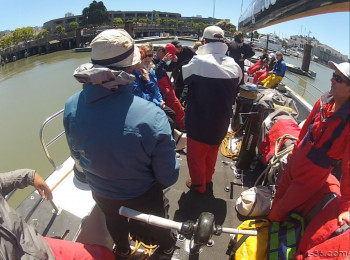GoPro Fogging
And how to prevent it
By Allen Edwards
Introduction
The promise of videos of my sailing was too good to pass up so I bought a GoPro Hero 2 shortly after they came out. I did get some good videos but all too often the images that came back would be fogged up. It got to the point that I just didn't want to bother to put the camera on the boat because I knew the videos would be fogged. I tried many things to prevent this but nothing worked until this last time.

A once in a lifetime opportunity to sail on a retired America's Cup boat on a beautiful day on San Francisco Bay. I wore my GoPro head band and recorded the entire fogged up sail. That was after trying the freezer approach to preventing fogging. The image to the left looks great, but it was taken at the dock before we actually did any sailing. The one at the right was after we actually got out and did some sailing. If you watch YouTube videos of sailing, you will even see people posting their adventures complete with fogging.
Background
Fogging is caused by condensation of the moisture inside the case caused by the lower temperature air outside the case. If the relative humidity in hour home where you seal the camera in the case is 60% and the temperature is 75 degrees F, then when the outside air gets to 60 degrees F the humidity would be 100% and you get condensation. But this does not explain the fact that the heat generated by the camera is an important part of the problem. All of my fogging incidents start when the camera points into the sun and the sun heats up the inside of the camera. You cannot explain this with just the due point explanation.The best explanation is that heating the camera is driving moisture out of the plastic case and this increases the moisture in the air in the case. Plastic absorbs moisture from the air and releases it as it is heated in a process knows as "bake-out". The explanation for what is going on in the GoPro case is that the camera itself is releasing moisture into the surrounding air as it bakes-out due to the heat from the camera itself and the added heat from the sun shinning through the lens.
Various "Cures"
- Use the open back. This always works but is obviously not acceptable for sailing or other applications where the camera will get wet.
- Leave the camera off most of the time. GoPro modified their software so the camera does not get hot when not actually filming. This is not a good solution for racing where you just want to turn the camera on and record the entire race, editing the important scenes later.
- GoPro Anti-Fog Inserts
Recommended by GoPro but these didn't work for me.
- Close case in front of an air conditioner.
- Leave case and camera in refrigerator or freezer for 20 minutes to overnight.
- Fill case with dry air for air can or scuba tank.
Original idea I didn't try
If fogging is caused by differences in the air inside the case compared to the air outside the case why not figure out how to make the air the same. I wanted to try this but never did. People who use an open back do not have fogging problems and as I am not actually taking the camera under water perhaps there is a way to keep the case open to the air but not open to waves hitting it. I considered vent pipes that would point down so splash would not get in. I considered GroTex but never could find how to buy a small piece. In the end I tried the cure outlined below and at least on this first outing all worked as promised.How to Cure Fogging
Finally I tried Rain-X. This followed by the video where it was all explained. A couple of tips I learned from trial and error. Apply enough Rain-X to the inside of the lens and swish it around so that all of the lens is exposed to the solution. It really doesn't matter if you use too much as you are going to pour it out. Then use a hair dryer on COLD to dry it. I held the case at a bit of an angle with the lens pointing up to facilitate gravity removing the Rain-X. Cool is not good enough. The hair dryer I used had a cool setting but it was still heated and that led to spots. I had to press the COLD button and hold it down to prevent any heat. You can feel the air with your hand and tell if it is heated at all. It doesn't take long to dry the Rain-X as it is very volatile. Hold the lens up to the light and you can see if you did a good job or not. The video at the right was taken with Rain-X on the lens. The camera is initially pointing directly into the sun and you can see that when the boat points away from the sun that the colors are sharp and saturated with no fogging. Compare that to the video in the background section and you will see a vast improvement.Video on applying Anti Fogging Solution
NOTICE: Some pages have affiliate links to Amazon. As an Amazon Associate, I earn from qualifying purchases. Please read website Cookie, Privacy, and Disclamers by clicking HERE. To contact me click HERE. For my YouTube page click HERE